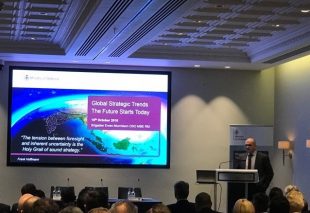
‘Global Strategic Trends – The Future Starts Today’ was published on Monday 15 October by the Ministry of Defence’s (MOD) thinktank, the Development, Concept and Doctrine Centre (DCDC). The document provides a strategic context for those involved in long-term policy, strategy and capability development.
The Global Strategic Trends (GST) report draws on analysis by the Development, Concepts and Doctrine Centre’s (DCDC) international Futures team, Whitehall departments, partner nations’ horizon scanners, industry and academia. The research aims to support those who are formulating policy, strategy, plans and force development, within Defence and across government.
Since its inception in 2001, the Strategic Analysis Programme (previously the Strategic Trends Programme) has undertaken continuous research to identify key drivers of change that will shape and reshape our world. This is the 6th edition of this report, which is updated every 4 years.
Many future trends discussed in GST – The future Starts Today will be familiar to the horizon scanning community, but evidence indicates that the rate of change is accelerating, and the level uncertainty is increasing.
Environmental stress is increasing, and the effects of climate change will have far-reaching consequences as floods, droughts, heatwaves and heavy rainfall become more intense and possibly more frequent. By 2050, there are likely to be around 2 billion more people, around 20% of the world’s population are likely to be aged over 60 and more people than ever will live in cities. Levels of health care and education will improve, and most people are likely to have access to virtually unlimited information. More people will be lifted out of absolute poverty and life expectancy will improve, however, inequality is likely to increase.
Technological change will have a profound impact on virtually every facet of our lives. For example, gene editing will allow previously untreatable genetic conditions to be cured. Processing power, the volume of data and connectivity will grow exponentially driving the development of artificial intelligence (AI) and quantum computing and the ability to solve problems of increasing complexity. But information will also be used to deliver cyber attacks and spread misinformation, creating uncertainty and fuelling grievances.
These and other trends are discussed in detail in the five thematic chapters: environment and resources; human development; economy, industry and information; governance and law. Because the trends impact differently on different parts of the world we have written 13 geographic chapters, each of which examines a specific region. We have also produced a stress map to illustrate where in the world we judge key stresses are likely to have greatest impact.
Whilst we have, as in previous editions of GST, used trends (discernible patterns of change) as our starting point we have included two new features in this edition of GST. The first is a series of ‘future worlds’ (produced in conjunction with Dstl) to explore alternate and plausible futures, including shocks, shifts and surprises. The second is an impact and uncertainty analysis that has drawn on multiple inputs to produce an assessment of the scale of impact and uncertainty (if the impact will be realised or not) and our confidence in that assessment. We anticipate that these features will help ensure that this edition of GST is more relevant and usable than previous editions.
The Future Starts Today, does not attempt to predict the future – it cannot. Instead, it is an aid to thinking about the future. What we want most of all for this edition of GST, is for colleagues and decision-makers across government to use it as a tool to think about the long-term future.
GST provides a great head start for specific horizon scanning exercises. The Government Office for Science Futures Toolkit shows how sources like this can be used in these exercises.
If you’d like to know more about MOD’s Futures work, or if you’d like to request a copy of the publication, you can get in touch with the team by e-mailing DCDC-strategictrends@mod.gov.uk